Hexagon
| Regular hexagon | |
|---|---|
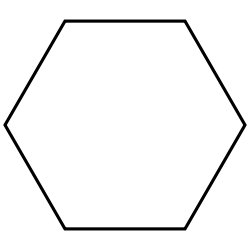 A regular hexagon |
|
| Edges and vertices | 6 |
| Schläfli symbols | {6} |
| Coxeter–Dynkin diagrams | |
| Symmetry group | Dihedral (D6) |
| Area (with t=edge length) |
  |
| Internal angle (degrees) |
120° |
| Properties | convex, cyclic, equilateral, isogonal, isotoxal |
In geometry, a hexagon is a polygon with six edges and six vertices. A regular hexagon has Schläfli symbol {6}. The total of the internal angles of any hexagon is 720 degrees.
Contents |
Regular hexagon

A regular hexagon has all sides of the same length, and all internal angles are 120°. A regular hexagon has 6 rotational symmetries (six lines of symmetry) and 6 reflection symmetries (rotational symmetry of order six), making up the dihedral group D6. The longest diagonals of a regular hexagon, connecting diametrically opposite vertices, are twice the length of one side. Like squares and equilateral triangles, regular hexagons fit together without any gaps to tile the plane (three hexagons meeting at every vertex), and so are useful for constructing tessellations. The cells of a beehive honeycomb are hexagonal for this reason and because the shape makes efficient use of space and building materials. The Voronoi diagram of a regular triangular lattice is the honeycomb tessellation of hexagons.
The area of a regular hexagon of side length  is given by
is given by 
An alternative formula for area is 
Length d is the distance between the parallel sides, or the height of the hexagon when it sits on one side as base, or the (minimal) diameter of the inscribed circle.
The area can also be found by the formula A=ap/2, where a is the apothem and p is the perimeter.
The perimeter of a regular hexagon of side length  is
is  , its maximal diameter
, its maximal diameter  , and its minimal diameter
, and its minimal diameter  .
.
If a regular hexagon has successive vertices A, B, C, D, E, F and if P is any point on the circumscribing circle between B and C, then PE + PF = PA + PB + PC + PD.
Cyclic hexagon
A cyclic hexagon is any hexagon inscribed in a circle. If the successive sides of the cyclic hexagon are a, b, c, d, e, f, then the three main diagonals intersect in a single point if and only if ace=bdf.
Related figures
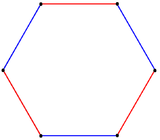 A regular hexagon can also be created as a truncated equilateral triangle, with Schläfli symbol t{3}. This form only has D3 symmetry. In this figure, the remaining edges of the original triangle are drawn blue, and new edges from the truncation are red. |
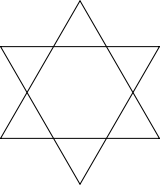 The hexagram can be created as a stellation process: extending the 6 edges of a regular hexagon until they meet at 6 new vertices. |
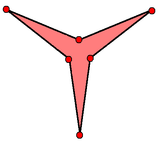 A concave hexagon |
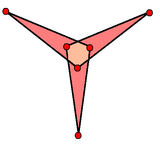 A self-intersecting hexagon |
Petrie polygons
The regular hexagon is the Petrie polygon for these regular and uniform polytopes, shown in these skew orthogonal projections:
| (3D) | (5D) | |||
|---|---|---|---|---|
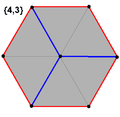 Cube |
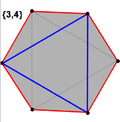 Octahedron |
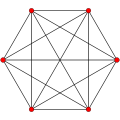 5-simplex |
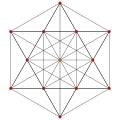 Rectified 5-simplex |
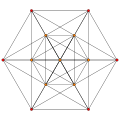 Birectified 5-simplex |
Polyhedra with hexagons
There is no platonic solid made of regular hexagons, because the hexagons tesselate, not allowing the result to "fold up". The Archimedean solids with some hexagonal faces are the truncated tetrahedron, truncated octahedron, truncated icosahedron (of soccer ball and fullerene fame), truncated cuboctahedron and the truncated icosidodecahedron.
| Archimedean solids | ||||
|---|---|---|---|---|
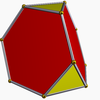 truncated tetrahedron |
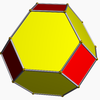 truncated octahedron |
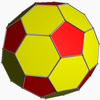 truncated icosahedron |
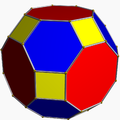 truncated cuboctahedron |
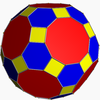 truncated icosidodecahedron |
And 9 Johnson solids:
- triangular cupola, elongated triangular cupola, gyroelongated triangular cupola, augmented hexagonal prism, parabiaugmented hexagonal prism, metabiaugmented hexagonal prism, triaugmented hexagonal prism, augmented truncated tetrahedron, triangular hebesphenorotunda
| Prismoids | ||
|---|---|---|
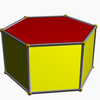 Hexagonal prism |
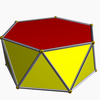 Hexagonal antiprism |
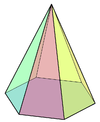 Hexagonal pyramid |
| Other symmetric polyhedra | |||
|---|---|---|---|
 Truncated triakis tetrahedron |
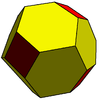 Truncated rhombic dodecahedron |
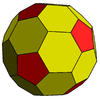 Truncated rhombic triacontahedron |
 |
Regular and uniform tilings with hexagons
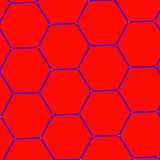 The hexagon can form a regular tessellate the plane with a Schläfli symbol {6,3}, having 3 hexagons around every vertex. |
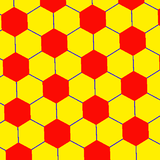 A second hexagonal tessellation of the plane can be formed as a truncated triangular tiling, with one of three hexagons colored differently. |
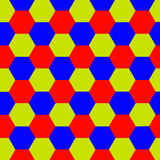 A third tessellation of the plane can be formed with three colored hexagons around every vertex. |
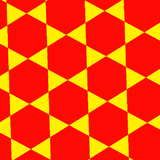 Trihexagonal tiling |
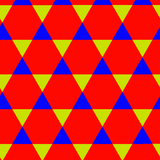 Trihexagonal tiling |
|
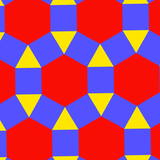 Rhombitrihexagonal tiling |
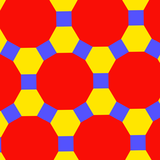 Truncated trihexagonal tiling |
Hexagons: natural and human-made
 A beehive honeycomb |
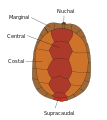 The scutes of a turtle's carapace |
||
 Crystal structure of a molecular hexagon composed of hexagonal aromatic rings reported by Müllen and coworkers in Chem. Eur. J., 2000, 1834-1839. |
 Naturally formed basalt columns from Giant's Causeway in Ireland; large masses must cool slowly to form a polygonal fracture pattern |
 An aerial view of Fort Jefferson in Dry Tortugas National Park |
 The James Webb Space Telescope mirror is composed of 18 hexagonal segments. |
 Metropolitan France has a vaguely hexagonal shape. In French, l'Hexagone sometimes refers to the European mainland of France aka the "metropole" as opposed to the overseas territories such as Corsica, Martinique or French Guiana. |
See also
- Hexagram: 6-sided star within a regular hexagon
- Unicursal hexagram: single path, 6-sided star, within a hexagon
- Hexagonal tiling: a regular tiling of hexagons in a plane
- Hexagonal number
- Hexagonal crystal system
External links
- Weisstein, Eric W., "Hexagon" from MathWorld.
- Definition and properties of a hexagon With interactive animation and construction with compass and straightedge.
- Cymatics - Hexagonal shapes occurring within water sound images
- Cassini Images Bizarre Hexagon on Saturn
- Saturn's Strange Hexagon
- A hexagonal feature around Saturn's North Pole
- "Bizarre Hexagon Spotted on Saturn" - from Space.com (27 March 2007)
|
|||||||||||||||||

